San Francisco Fire Department
-
- Meet SFFD’s New Fireboat Technology Maritime Reporter, Nov 2015 #126
Surrounded on three sides by water with the Pacific Ocean to the west, the Golden Gate Strait to the north, and San Francisco Bay to the East, the San Francisco Fire Department (SFFD) currently relies on two old and refurbished fireboats, the Phoenix (built in 1954) and the Guardian (built in 1951) to serve as fire protection assets for the waters around the City.
San Francisco requires fireboats for a wide range of protective coastal duties. Since San Francisco lies near a major earthquake fault line, a fireboat could serve as a pumper in the event of an earthquake where underground water mains may break and render hydrant water pressure useless. A fireboat could pump water straight from the coast to service fire engines inland and keep attack hoses supplied with adequate water pressure. A fireboat could also serve as a rescue craft for water-related emergency situations, or serve as protectors for container ships visiting the Port of Oakland, and for oil tanker ships delivering to the oil refineries in Richmond, the city above Oakland. San Francisco waters also have four steel and concrete bridges crossing to the north and eastern counties that see heavy daily traffic.
Jensen Maritime Consultants has won the award to design the new San Francisco fireboat, the first new fireboat for the City in over 50 years. The Phoenix was built in 1954 and the Guardian (built in 1951) was purchased used from the City of Vancouver, BC. The new fireboat will be a custom design, and the one thing that is really unusual about this boat is that it can pump 18,000gpm at 150psi, or it can pump 6,000gpm at 300psi and 6,000gpm at 15psi. Line attack hoses could attach to discharge manifolds on deck so the fireboat could serve as a pumping station in case of an earthquake where the water mains break underneath the street.
The new SFFD fireboat comes with unique design features and capabilities.
In particular, this design has five fire monitors: two dual monitors in front, one on the boathouse facing forward, and two on the corners of the second deck facing the rear. The Jensen design has twin searchlights mounted over the bridge’s roof, a mast with radar and communications antennas, twin smokestacks canted towards the rear, a deck crane on the starboard side, port and starboard openings for coming alongside piers and jet skis, or for easier access for divers or for hauling in swimmers in distress or debris, and on the stern ramp a Rigid Inflatable Boat (RIB) with an outboard motor. The RIB in itself is a unique asset as it allows the SFFD to conduct inspections, ship boarding, and search and rescue operations independent from the new fireboat. To launch, the RIB slides down the stern ramp via gravity into the water. To retrieve the RIB, a winch mounted at the forward end of the pedestal hooks up to the RIB and hauls it aboard. (Both the Phoenix and Guardian carry motorized skiffs, but do not have stern ramps to launch or retrieve them).
Two sets of stairs flank the RIB ramp to lead to a platform at the stern for launching or retrieving materials or swimmers. The deck of the new Jensen-designed fireboat also has 24 vertical discharge manifolds to hook up line attack hoses for pumping to fires offshore.
A Chemical Biological Radiation Nuclear and Explosive (CBRNE) system allows firefighters to plug masks into the air system aboard the boat and breathe clean air during firefighting or Hazardous Materials situations. For pumping water, the new fireboat has three fire pumps. The two propulsion engines for sailing each have a water-driving fire pump mounted on the other end of the propulsion engine and there is one dedicated fire engine with a fire pump mounted on it. When sailing, the boat can pump 6,000gpm at 150psi by using the dedicated fire engine and pump only. At dockside, or when the propulsion engines are not being used for sailing, all of the engines (two propulsion and the dedicated fire engine) can be used to operate the fire pumps to produce 18,000gpm at 150psi. The engines also have a high-pressure mode where they can pump 6,000gpm at 150psi and 6,000gpm at 300psi. These incorporated features make the newest SFFD fireboat able to handle emergency situations that the older fireboats cannot. And with an inventory of now three fireboats, the San Francisco Fire Department could theoretically pump sea water inland on all three sides of the city in the event that major fires erupt in three different locations as a result from a devastating earthquake.
The new fireboat will have three interior decks: the top deck is the pilothouse; the main deck has a command center with a head (restroom) and an equipment storage room; and the bottom deck has a workshop, a storage room, an engine room, a steering gear room, and a forepeak storage space. The boat has no living or sleeping area, although it does have a Self-Contained Breathing Apparatus (SCBA) filling, storage, and distribution area where operators could plug into the stations locally on the boat’s and breathe clean air when working onboard if necessary. The ship does not have a dedicated Decontamination (Shower) Room so a portable facility would be set up on deck or at the dock. The mast has a standard set of navigation lights and radar. The new fireboat will have a crew of three and four additional firefighters to either man the monitors or deploy from the RIB.
Estimated costs range from $9-$12 million dollars.
As of May 15, 2013, a $7.8 million Federal Grant was lost because the San Francisco Fire Department did not spend the money in the given time frame. The grant was awarded by the Federal Emergency Management Agency (FEMA) in 2009 to San Francisco for Port Security, namely the funding of a new fireboat in which the City would have to match the grant funds to pay for the rest of the fireboat’s cost. The deal was that SFFD would have the boat built and in service in two-and-half years. Apparently, that didn’t happen. The SFFD had to first pick a design and one of the bidders dropped out due to a disagreement of the process used to award the contract. So it took more months to get a new $400,000 contract established. When the first round of construction bids went out, the City rejected two of the bids. Therefore, a second round of bids went out in February 2013 with a winning selection of $12 million to build the new fireboat. However, the deadline to have the new fireboat in service and to secure the Federal Grant is at the end of June 2013, and with construction not even started, it will be impossible to build the new fireboat in time. Even lobbying by Senators Dianne Feinstein and Barbara Boxer, and House Minority Leader Nancy Pelosi, was not enough to save the FEMA Grant deal. SFFD hopes to apply again for another grant for the fireboat.
According to Mindy Talmadge, the Public Affairs Officer for the San Francisco Fire Department.
“The Department was unable to make use of the original award given a variety of delays in the project (You must understand that there are multiple agencies involved in the advertising, scoring and awarding of a bid that the Fire Department has absolutely no control over. It is that process that took the extensive time that made it impossible for the Fire Department to make use of the funds in the allocated time), and the funding was reallocated throughout the region to other projects. However, in August of 2013, the Department was the recipient of a new Federal grant award for the project. Currently, contract negotiations have begun on the contract for the construction of the boat, and the Department hopes to begin construction of the vessel in the coming months.”
At the end of June 2014, “Jensen Maritime has been selected to provide detail production engineering and construction management for the production of one 88’ x 25’ Super Pumper NFPA Type II Fireboat for the San Francisco Fire Department. The fireboat contract-design was also completed by Jensen for the City of San Francisco in 2012. The vessel will be built at Vigor Industrial in Seattle and is expected to be completed during the late summer of 2015. The vessel will operate in San Francisco Bay, San Pablo Bay and the Pacific Ocean within five miles of shore and the adjoining inland waterways.”Specs for the new SFFD Fireboat
Designer Jensen Maritime
Builder Vigor (Seattle)
Length o.a., molded 88 ft.
Breadth, Molded 25 ft.
Depth, Molded 14.3 ft.
Draft, Molded (approx. Max Load) 9 ft.
Speed in Full Load Condition 11.5 knots (Predicted)
Propulsion 2 x Caterpillar C18 ACERT engines
Engine Horsepower (each) 2 x 493 bhp
at 2300 rpm
Crew Complement 3 crew + 4 firefighters
Fire Engine 1 x Caterpillar C18 ACERT engine
Fire Pumps 3 x CounterFire ESF 300-550
Pump Capacity 18,000 gpm
Fuel Oil Capacity 10,900 gal. @ 95%
Fresh Water Capacity 250 gal. @ 100%
Fire Fighting Foam (FFF) Capacity 1,000 gal.
@ 95%
Lube Oil Capacity 175 gal. @ 95%
Displacement, Full Load 260 LT (Estimated)
(As published in the November 2014 edition of Maritime Reporter & Engineering News - http://magazines.marinelink.com/Magazines/MaritimeReporter)
-
- Moose to the Rescue Marine News, Dec 2018 #32
150 Gallon Diesel TankDeck Lights: Imtra OffshoreService: Joint Police/FireThermal Imaging Camera: FLIR M-SeriesCapacity of Fire Pump: 1,500GPMSan Francisco Fire DepartmentHeading west once again to Moose’s very backyard, San Francisco Fire Department’s new M2-28 Catamaran is another variant of Moose Boats’
-
- On Patrol: North River Boats Maritime Reporter, Mar 2014 #48
a high speed craft designed for pursuit, quick maneuvering and excellent sea keeping capabilities. The first of these boats was built for the San Francisco Fire Department and will serve as a rescue platform working near the Golden Gate Bridge. One of its main uses will be for Search and Rescue missions. The
-
- Moose Boats’ Fire Rescue Catamaran Marine News, Sep 2014 #40
numerous fire fighting vessels for agencies throughout the United States including Richmond Fire Department, Tiburon Fire Rescue District, San Francisco Fire Department and Humboldt Bay Harbor Recreation and Conservation District in California, Old Saybrook Fire Department in Connecticut, Lewes Fire Department
-
- San Francisco’s New Fireboat is Like No Other Marine News, Dec 2016 #34
of marine vessels, Jensen today performs larger and more complex projects with outcomes that benefit a wide range of customers. Today, the San Francisco Fire Department’s response capabilities are markedly better because of it. Builder: Vigor LOA: 88’ Breadth: 25’ Depth: 14’-4” Draft: 9’ Construction:
-
 )
March 2024 - Marine Technology Reporter page: 27
)
March 2024 - Marine Technology Reporter page: 27SEA-KIT USV Maxlimer returning from HT-HH caldera in Tonga. © SEA-KIT International data and further assess ecosystem recov- ery. What is known, noted Caplan-Auer- bach, is that the impact of submarine vol- canoes on humans is rare. “The HT-HH eruption was a tragedy, but it was very unusual. It let us
-
 )
March 2024 - Marine Technology Reporter page: 15
)
March 2024 - Marine Technology Reporter page: 15as single axis (pan rotation) and dual axis (pan & tilt rotation) configurations with numerous connector options. For More Information and Headquarters – San Diego, CA USA Technical Specifications Phone: (858) 565-8500 Contact: [email protected] or Email: [email protected] www.rosys.com Visit: www.rosys
-
 )
March 2024 - Marine Technology Reporter page: 9
)
March 2024 - Marine Technology Reporter page: 9from marinas along the western coast. The exact number of lizing laser detection systems can detect mines just below the mines, as well as their locations, remains largely a mystery, surface, even those hiding in murky water. The Airborne Laser although reports suggest that over three hundred have been
-
 )
April 2024 - Maritime Reporter and Engineering News page: 28
)
April 2024 - Maritime Reporter and Engineering News page: 28an underway replenishment at sea in the Atlantic Ocean, July 17. leum products to our storage and distri- bution sites around the world. The MSC The San Antonio-class amphibious transport dock ship USS Arlington (LPD contracting team and the skill set of con- 24) sails alongside the Henry J. Kaiser-class
-
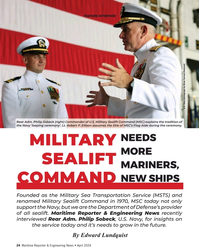 )
April 2024 - Maritime Reporter and Engineering News page: 24
)
April 2024 - Maritime Reporter and Engineering News page: 24FEATURE INTERVIEW U.S. Navy photograph by Brian Suriani/Released Rear Adm. Philip Sobeck (right) Commander of U.S. Military Sealift Command (MSC) explains the tradition of the Navy ‘looping ceremony’. Lt. Robert P. Ellison assumes the title of MSC’s Flag Aide during the ceremony. NEEDS MILITARY MORE
-
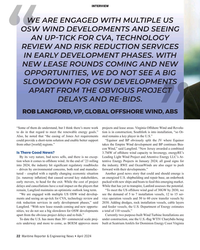 )
April 2024 - Maritime Reporter and Engineering News page: 22
)
April 2024 - Maritime Reporter and Engineering News page: 22INTERVIEW WE ARE ENGAGED WITH MULTIPLE US OSW WIND DEVELOPMENTS AND SEEING AN UP-TICK FOR CVA, TECHNOLOGY REVIEW AND RISK REDUCTION SERVICES IN EARLY DEVELOPMENT PHASES. WITH NEW LEASE ROUNDS COMING AND NEW OPPORTUNITIES, WE DO NOT SEE A BIG SLOWDOWN FOR OSW DEVELOPMENTS APART FROM THE OBVIOUS
-
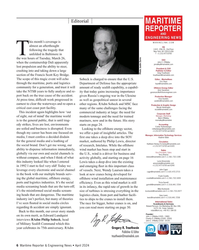 )
April 2024 - Maritime Reporter and Engineering News page: 6
)
April 2024 - Maritime Reporter and Engineering News page: 6Editorial MARITIME REPORTER AND ENGINEERING NEWS his month’s coverage is M A R I N E L I N K . C O M almost an afterthought HQ 118 E. 25th St., 2nd Floor following the tragedy that New York, NY 10010 USA T +1.212.477.6700 Tunfolded in Baltimore in the wee hours of Tuesday, March 26, CEO John C.
-
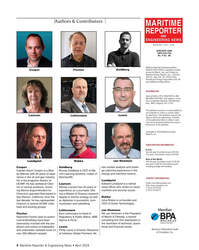 )
April 2024 - Maritime Reporter and Engineering News page: 4
)
April 2024 - Maritime Reporter and Engineering News page: 4Superintendent for experience as a journalist. She maritime and security issues. Chevron’s operated ? eet based in has a Master of Science research San Ramon, California. Over the degree in marine ecology as well Rokka last decade, he has represented as diplomas in journalism, com- Juha Rokka is
-
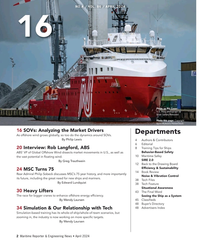 )
April 2024 - Maritime Reporter and Engineering News page: 2
)
April 2024 - Maritime Reporter and Engineering News page: 2NO.4 / VOL. 86 / APRIL 2024 16 Photo on the Cover: U.S. Navy photograph by Brian Suriani/Released Photo this page: Copyright Björn Wylezich/AdobeStock 16 SOVs: Analyzing the Market Drivers Departments As offshore wind grows globally, so too do the dynamics around SOVs. By Philip Lewis 4 Authors & Contribut
-
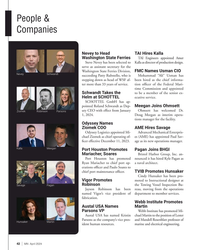 )
April 2024 - Marine News page: 42
)
April 2024 - Marine News page: 42People & Companies Nevey to Head TAI Hires Kalla Washington State Ferries TAI Engineers appointed Amer Steve Nevey has been selected to Kalla as director of production design. serve as assistant secretary for the FMC Names Usman CIO Washington State Ferries Division, Nevey Schwandt succeeding Patty
-
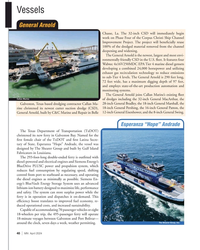 )
April 2024 - Marine News page: 40
)
April 2024 - Marine News page: 40Vessels General Arnold Chasse, La. The 32-inch CSD will immediately begin work on Phase Four of the Corpus Christi Ship Channel Improvement Project. The project will bene? cially reuse 100% of the dredged material removed from the channel deepening and widening. The General Arnold is the newest,
-
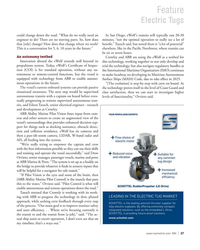 )
April 2024 - Marine News page: 37
)
April 2024 - Marine News page: 37Feature Electric Tugs could change down the road. “What do we really need an In San Diego, eWolf’s transits will typically run 20-30 engineer to do? There are no moving parts. So, how does minutes, “not the optimal operation to really see a lot of that [role] change? How does that change where we work?
-
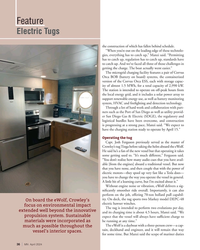 )
April 2024 - Marine News page: 36
)
April 2024 - Marine News page: 36monitoring system, HVAC and ? re? ghting and detection technology. Through a lot of hard work and collaboration with part- ners such as the Port of San Diego as well as utility provid- er San Diego Gas & Electric (SDGE), the regulatory and logistical hurdles have been overcome, and construction is
-
 )
April 2024 - Marine News page: 35
)
April 2024 - Marine News page: 35saved 178 tons of nitrogen oxides, 2.5 tons of diesel particulate matter and 3,100 metric tons of carbon. Receiving a charge While eWolf is already in San Diego, ready to go, its of? - cial entry into service has been put on a short hold as it awaits the completion of a specially designed shore charging
-
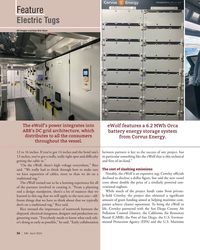 )
April 2024 - Marine News page: 34
)
April 2024 - Marine News page: 34. To bring the eWolf to don’t on a traditional tug,” Rice said. Rice stressed the importance of teamwork between the life, Crowley partnered with the San Diego County Air Pollution Control District, the California Air Resources shipyard, electrical integrator, designer and production en- Board (CARB)
-
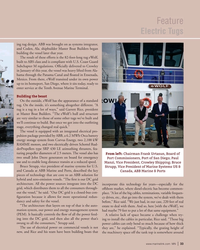 )
April 2024 - Marine News page: 33
)
April 2024 - Marine News page: 33heavy lifted from Ala- bama through the Panama Canal and ? oated in Ensenada, Mexico. From there, eWolf transited under its own power up to its homeport, San Diego, where it sits today, ready to enter service at the Tenth Avenue Marine Terminal. Building the beast On the outside, eWolf has the appearance
-
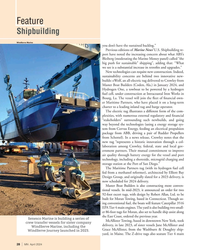 )
April 2024 - Marine News page: 28
)
April 2024 - Marine News page: 28air quality through battery energy for the vessel and port technology, including a shoreside, microgrid charging and storage station at the Port of San Diego.” The Maritime Partners tug (with its hydrogen fuel cell fed from a methanol reformer), architected by Elliott Bay Design Group, and originally
-
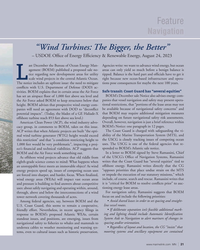 )
April 2024 - Marine News page: 21
)
April 2024 - Marine News page: 21suggests that BOEM through, above and below the interconnections of a wind focus on and include the following priorities: tower network covering thousands of acres. • Avoid shared leases in order to set spacing and straight- Among federal agencies, say, between BOEM and the line vessel routes. U.S.
-
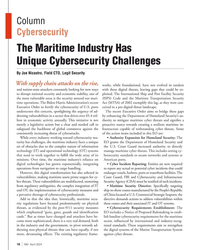 )
April 2024 - Marine News page: 18
)
April 2024 - Marine News page: 18Column Cybersecurity The Maritime Industry Has Unique Cybersecurity Challenges By Joe Nicastro, Field CTO, Legit Security With supply chain attacks on the rise, works, while foundational, have not evolved in tandem and nation-state attackers constantly looking for new ways with these digital threats
-
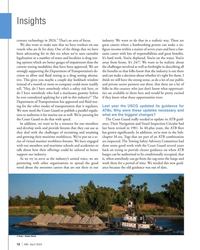 )
April 2024 - Marine News page: 12
)
April 2024 - Marine News page: 12Insights century technology in 2024.” That’s an area of focus. industry. We want to do that in a realistic way. These are We also want to make sure that we have workers on our great careers where a hardworking person can make a six- vessels who are ? t for duty. One of the things that we have ? gure
-
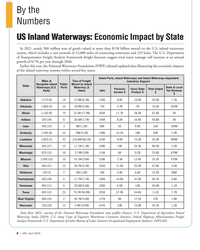 )
April 2024 - Marine News page: 8
)
April 2024 - Marine News page: 8By the Numbers US Inland Waterways: Economic Impact by State In 2021, nearly 500 million tons of goods valued at more than $158 billion moved on the U.S. inland waterways system, which includes a vast network of 12,000 miles of connecting waterways and 219 locks. The U.S. Department of Transportation
-
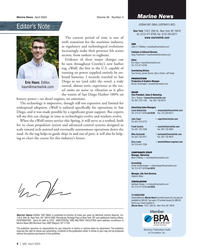 )
April 2024 - Marine News page: 4
)
April 2024 - Marine News page: 4Writers running on power supplied entirely by on- Tom Ewing, James Kearns, Barry Parker, Jeff Vogel board batteries. I recently traveled to San PRODUCTION Production & Graphics Manager Diego to see (and ride) the vessel, a truly Eric Haun, Editor, Nicole Ventimiglia • nicole@marinelink
-
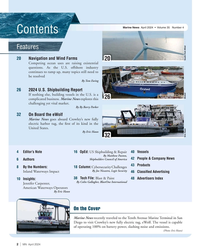 )
April 2024 - Marine News page: 2
)
April 2024 - Marine News page: 2Jennifer Carpenter, American Waterways Operators By Eric Haun On the Cover Marine News recently traveled to the Tenth Avenue Marine Terminal in San Diego to visit Crowley’s new fully electric tug, eWolf. The vessel is capable of operating 100% on battery power, slashing noise and emissions. (Photo:
-
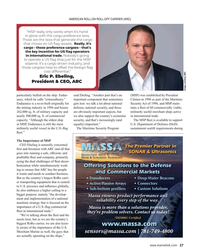 )
February 2024 - Maritime Reporter and Engineering News page: 27
)
February 2024 - Maritime Reporter and Engineering News page: 27AMERICAN ROLL-ON ROLL-OFF CARRIER (ARC) “MSP really only works when it’s hand in glove with the cargo preference laws. Those are the laws that generate the cargo that moves on US ? ag vessels. Really, it’s cargo – those preference cargoes – that’s the key incentive for US ? ag operators in internatio
